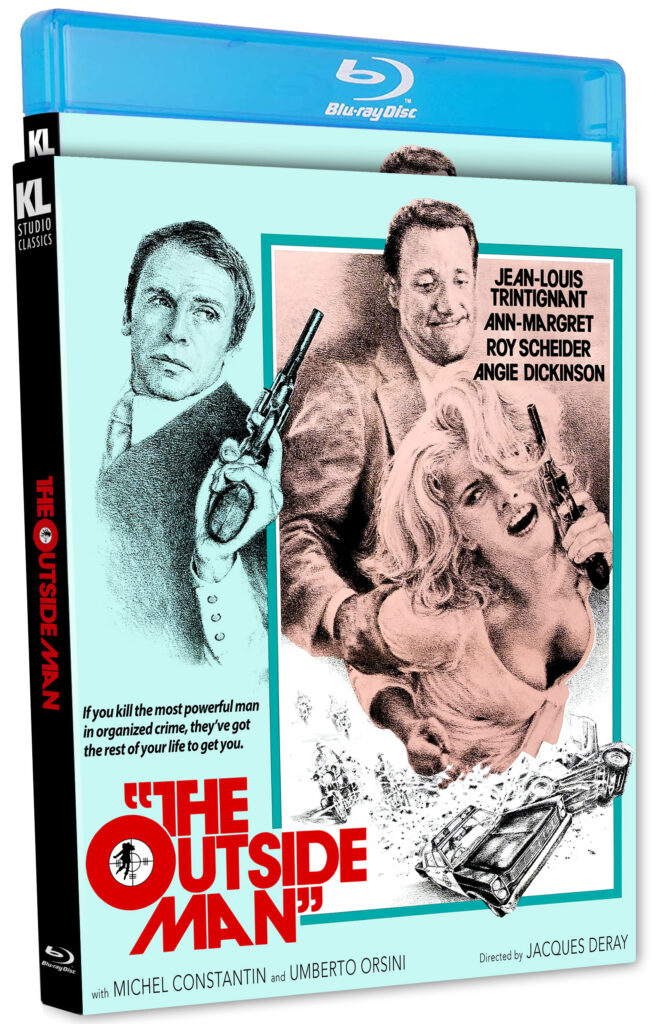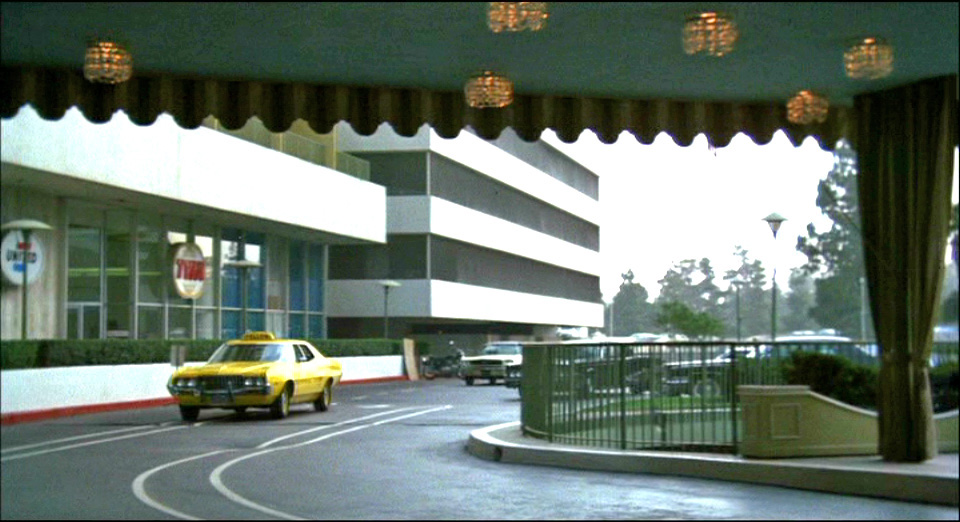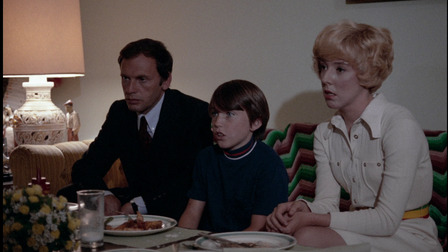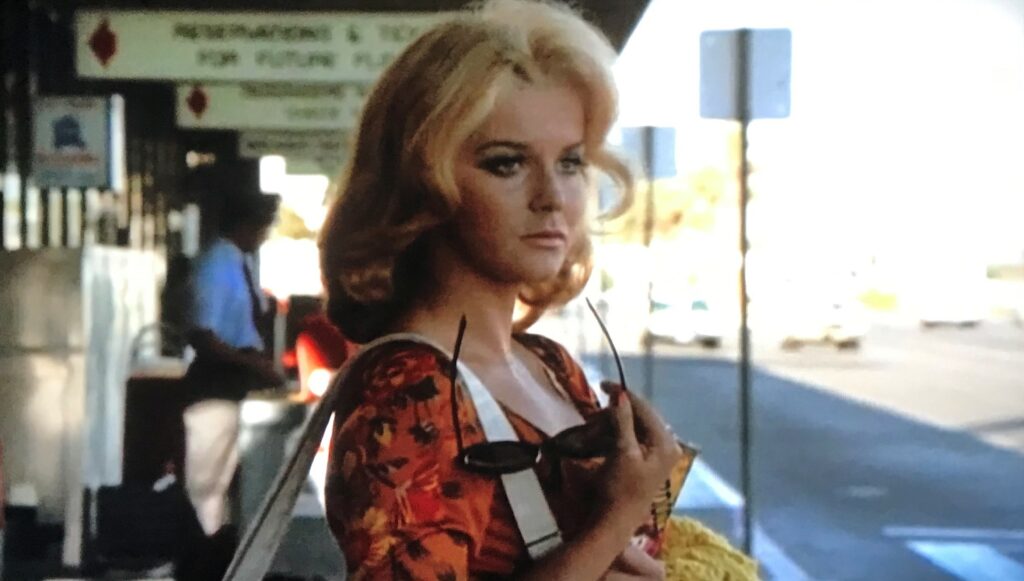Death, American Style
DIRECTOR: JACQUES DERAY/FRENCH-ITALIAN
STREET DATE: JANUARY 9TH, 2024/KINO LORBER STUDIO CLASSICS

A mysterious Parisian (Jean-Louis Trintingant) arrives in Los Angeles to kill a powerful businessman with mob ties (Ted de Corsia) in his luxurious Beverly Hills home, only to find himself targeted immediately after by a relentless hitman (Roy Scheider). On the run, the man we learn is Lucien Bellon eventually contacts his connected friend Antoine (Michel Constantin) back in Paris, who puts him in touch with off-hours nightclub worker Nancy Robson (Ann-Margret), who in turn manages to secure Bellon safe passage back home. Realizing he won’t be safe wherever he is, however, Lucien gradually unravels the mystery of his hiring and subsequent targeting, uncovering an illicit romantic conspiracy between the late Kovacs’ cold-hearted widow (Angie Dickinson) and his unscrupulous son (Umberto Orsini).

Climaxing with a gunfight at a funeral home, this French-Italian, multiple LA location-shot Eurocrime production takes viewers on a vivid journey to early 1970s streets, motels, hotels, lobbies, mansions, amusement park ruins, topless bars, daylight diners, and nighttime stations; in all, proving through its closely-observed mise-en-scene, from the privileged distance of now 50-some years, that the past is indeed another country. Director Jacques Deray and co-screenwriter Jean-Claude Carrière’s existential thriller The Outside Man offers its own enticing viewing passport, making movie-tourists of us all through its recent 4K restoration of an outsider’s vision to an often bewilderingly now-foreign world. With Kino Lorber’s January 2024 Blu-ray, presenting both the French language Un Homme est mort and a rediscovered, uncut version of the English-language version on two separate discs, The Outside Man is an always intriguing film journey well worth taking.
The plot, as such, dispensed with, one supposes we could move right along to the unique feel of the film, which is much more difficult to pin down in words. With its near-emotionless, blank slate of a protagonist, drifting through neon-lit nights and sun-bleached days, The Outside Man plays very much like a non-Hollywood view of Hollywood and its environs, the time capsule-like distancing of cone-shaped phone booths, TV desk-sets blaring in bus stations, and dubiously “sterilized”, coin-operated electric shavers in public restrooms(!) adding still other dimensions to the inherently outsider perspective of its filming. More so than even similar productions of the time, place, and genre – the then-recent breakup of the classical studio system bringing a natural realism to films unseen since the silent era, with cameras and crews setting up on actual locations as opposed to studio-bound camera-processes and set-recreations – The Outside Man with its precision-minded director and canny, mischievous co-scenarist presents LA very much as they then found it.
LA definitely, and even defiantly, plays itself here, its sprawling, smoggy, over-commercialized, tawdry, run-down, built-up extremities simply shown As-Is; and is certainly depicted, unmercifully, with No Apologies. Its wealth of character types and familiar faces atmospherically populating its many off-avenues, these include grizzled noir mainstay Ted de Corsia in a role ghoulishly appropriate for an actor’s final film, Roy Scheider looking post-French Connection (1971) cool in silently-extended chase sequences, future Mary Tyler Moore Show castmember Georgia Engels deceptively airheaded in serving her Ralphs parking lot-assailant chicken cacciatore back at her apartment, with a very young Jackie Earle Haley as her son having the smirk wiped off his face with two sharp, savage slaps to the cheek; one could go on to make similar praisings of vivid turns from Alex Rocco, John Hillerman, and Talia Shire(!!) among still others. All of whose consistent eccentricity of presentation, albeit through a steady prism of stark realism, extends to Michel Legrand’s hard-funk score, production designer Harold Michelson’s alternately kitschy, classy, tasteless, and timely interior bric-a-brac, and Henri Lanoë’s languid, dreamscape-like editing.

Its dry, ruthless humor building on its dark, morbid tone, one can’t help connecting the aggressive billboards, flashing slogans, and blaring street signs virtually engulfing our pursued, character-deficient antihero in viewing. Whether trying to push the bloodied body of an ex-Jesus Freak to one side as he barrels down the highway, or tentatively bowing in polite befuddlement to a nude dancer covered head-to-foot in postmortem-like, white-spangled pancake makeup, or standing in frozen contemplation of the stuffed and chair-mounted corpse of his initial quarry in a Forest Lawn Cemetery-like display room, death is omnipresent to the equally relentless capitalist excesses surrounding him at all turns. The ruins of the former beachfront amusement park has already been mentioned, but considered alongside the (multiply fatal) shootout in the funeral parlor, and extending through the pristine green lawn of the cemetery, in which Lucien’s getaway vehicle of immediate ill-convenience is no less than a back-loaded, white-draped hearse, may suggest the film’s blank-white and windscreened conclusion without having to here spoil it.

For a city/location that has similarly inspired such indelible titles as Evelyn Waugh’s The Loved One (1948), along with its 1965 filming by Tony Richardson, Ross MacDonald’s hard-boiled detective mystery The Way Some People Die (1951), and perhaps most forcefully Jessica Mitford’s shattering 1963 expose of (mainly) LA’s criminally commercialized funeral industry in The American Way of Death, one might symbolically add Jacques Deray and Jean-Claude Carrière’s tableau-centered image of Roy Scheider’s soon-to-be-targeted hitman-of-a-hitman collapsing in front of the Kovacs’ Beverly Hills gate. In addition to the two viewing options previously mentioned of the rediscovered, restored, and uncut version of the English language The Outside Man with the similarly restored French-language cut Un Homme est mort, which are beautifully ugly in high definition and advantageously share the unearthly calm and measured tones of multilingual Jean-Louis Trintignant’s trance-lulling speaking voice, this virtual death-tour of early 1970s LA also comes with the best audio ridealong for its subject, setting, period, genre, and style connected to the alphabetically-listed voices and views of Howard S. Berger, Steve Mitchell, and Nathaniel Thompson.
In line with the many commentaries I’ve enjoyed from these guys, I can reverse-alphabetically express appreciation here first for Thompson’s expertise on the career and unique talents of Ann-Margret, precisely opposite to the coldness and inscrutability of near-contemporary Angie Dickinson, the former of whom appears equal to her achingly realistic and three-dimensional character’s vehicle choice of a beat-up pink Thunderbird (!!!); next, Mitchell’s “location junky” eye for what one might term the foreign filmmakers’ ‘creatively selective’ or ‘imaginatively curated’ approach to actual Los Angeles-area geography, in which a shot down the Sunset Strip, say, can with one cut shift suddenly three miles across town; and finally Berger’s midnight-like connections and associations to Michel Constantin’s screen-continuum of tough guys, the form-playing and structure-altering genre “celebrations” of screenwriter Jean-Claude Carrière, and the complementary and contemporary movie mischief-making of Robert Altman, particularly with the always strangely relevant Brewster McCloud (1970). (To Berger’s brilliantly tossed-off point about actor Roy Scheider’s seamless onscreen embodying of points of view and personalities as diverse throughout his varied career as directors Steven Spielberg, William Friedkin and John Frankenheimer, particularly for the latter in his later and similarly-themed 52 Pick-Up [1986], also with Ann-Margaret, I might also add the actor’s unmentioned but perhaps too obvious role of Joe Gideon for Bob Fosse in All That Jazz [1979]. With that role in particular, and possibly those others somewhat less directly, one can’t help but feel Scheider may have been intuitively performing warts-and-all aspects of his director’s personas and viewpoints that the directors themselves may not have fully realized. All of which is a long way of testifying to Scheider’s seemingly effortless and always effective naturalism wherever he appeared.)
In short, as the preceeding parenthetical might attest (to the shame of any and all pretense to “writerly soundness of structure”; pshaw!) I love these guys’ always interesting and on-topic tangents, intriguing off-avenues, and associative turn-ons; their chasing down of ideas, themes, and connections as involving and exciting for me as a foreigner’s pulse-pounding view of and escape into an increasingly strange land.
Because movie watchers themselves are initially strangers to whatever directors reality they choose to nightly submit themselves, and an outsider’s view is always potentially the most intriguing. Kino Lorber’s presentation of this 4K restoration brings a previously under-known title to the more deserving prominence of its night time visions, side-mirror views, and death-location dreams.
Images in this review are used only as a reference to the film and do not reflect the image-quality of this new restoration or Blu-ray transfer.

